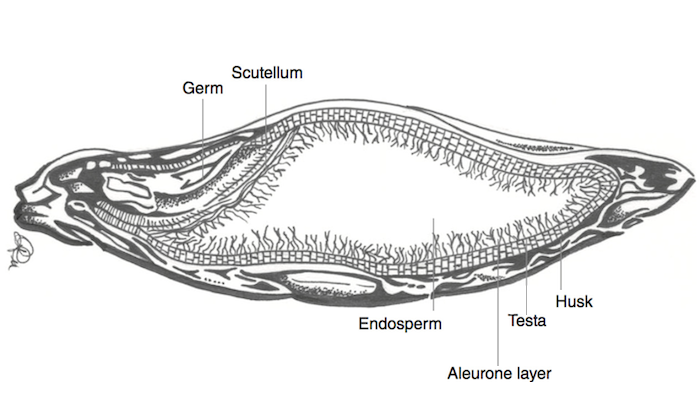The Science of Malting
The shining copper stills and the clear liquid streaming from the condenser may be the most recognizable symbols of distillation. But the journey from grain to glass begins long before distillation, or even fermentation.
After the farmer grows the grain with loving care, it is dried to protect it from fungus and bugs. Corn, rye, and other grains are usually ready for the distiller to use at this point, but barley is delivered to a professional, the maltster, who processes it through a crucial step of malting.
In my experience, Malting is one of the stages that whiskey education class discuss the least. But it is an integral part of the process and once you look into its science and talk to the people who malt grains professionally, you begin to appreciate how much craftsmanship is involved.
The First Goal
All of the grains used in whiskey making contain starch. Simply put, starch is long chains, or branching tree-like structures of sugar molecules (glucose). Within grain, the starch structures are tightly entangled and compacted into small grains. The grains, in turn, are held in a matrix of protein. This forms the endosperm of the grain - the biological structure that holds the fuel reserve for the young plant that would grow from the grain.
The brewer needs to extract the sugar, currently locked away as starch, so that yeast can consume it. During fermentation, the yeast convert the sugar into the alcohol. And the distiller extracts the alcohol, along with other flavorful compounds to make the spirit he ages in barrels to make whiskey.
However, the starch must be liberated from its protein matrix first. Vic Cameron, the lead instructor of the Edinburgh Whiskey Academy, draws an analogy of starch in its protein matrix to that of hazelnuts trapped in a matrix of chocolate in a delicious chocolate bar. The maltster wants to melt the chocolate - freeing the hazelnuts.
One way to release the starch is simply to crush the grain in a mill, which is the step that immediately follows malting in a whiskey production flowchart. All of the grains are milled, but corn and rye usually skip the malting step; their starches are released by the physical action of the mill rather than the biochemical processes of malting.
But, in addition to liberating starch, the maltster has another crucial goal to reach and will exploit nature to get there.
The Second Goal
Yeast is a simple fungus. When living in an environment with little oxygen, it consumes very simple sugars, uses them for fuel, and produces alcohol and carbon dioxide as waste products.
Even though starches are made of sugar, their intricate chains and branches are just too overwhelming. To be a suitable food for yeast, the entangled sugar molecules must be chemically broken apart. Nature’s tools that will do that are called enzymes. Barley can naturally produce enzymes as part of its germination cycle, and the maltster cleverly takes advantage of this.
To do that, the seed is steeped in warm water. Believing spring has arrived, the barley kernel begins to grow—setting off the chain of biological processes that the maltster harnesses to allow later steps to convert starch to sugar.
Malting
To achieve his goals, a maltster processes the grain through three primary steps: steeping, germination, and kilning.
Steeping is the first step, in which the grain is repeatedly submerged in water and then drained, to allow it to breathe and release waste products (like carbon dioxide). This process hydrates the kernel, activates the embryo, and prepares the seed for germination.
Once it has taken in the right amount of water, the barley kernel begins to germinate. The tiny plant awakens, triggering a cascade of hormones that activate enzymes to break down the grain’s internal structure—a key step in making starch and enzymes available for later use in fermentation.
However, if germination continued unchecked, the growing seedling would consume the very starches and enzymes needed for fermentation, leaving little behind for brewers and distillers. To prevent this, the maltster carefully dries the grain in a kiln, halting the growth process at just the right time. This preserves the essential starches and enzymes, which will later be used in mashing and fermentation—critical processes later in the whiskey making process that convert the starches in all the grain into fermentable sugars, then distillers’ beer and, ultimately, whiskey.
Biological Processes
At its core, malting is the controlled germination of barley. When a barley kernel begins to sprout, it activates natural enzymes that break down key structural components of the grain, including the protein matrix that encases its starch granules. This transformation unlocks the energy reserves of the grain, making them accessible for fermentation. Several key biological structures and hormones are involved in this transformation:
Water Absorption via the Micropyle
The micropyle, a small pore near the embryo, is the primary entry point for water during steeping, the first stage of malting. As water enters, it rehydrates the dormant seed, awakening its biological processes and triggering germination. To ensure even absorption across all kernels, the maltster carefully regulates the duration and frequency of water exposure.
Growth Signaling Through Hormones
Hormones are chemical messengers that coordinate biological processes within an organism. In the barley kernel, once the embryo is hydrated, a structure within it called the scutellum activates and releases a plant hormone known as gibberellic acid into the seed. This hormone travels to the aleurone layer, a thin tissue surrounding the endosperm, which responds by producing enzymes that break down the protein matrix and convert starches into fermentable sugars.
Enzymes Begin Their Work
Enzymes are biological catalysts—specialized proteins that speed up biochemical reactions without being consumed in the process. In response to gibberellic acid, the aleurone layer begins producing three key types of enzymes:
Amylases (α-amylase and β-amylase) – These enzymes break down the starch molecules into simple sugars. Alpha (α) amylase cuts starch molecules at random points to create smaller chains, while Beta (β) amylase works from the ends of these chains to release a simple sugar called maltose.
Proteases – Degrade the protein matrix, freeing the starch. (The amino acids resulting from the breakdown of proteins also help feed yeast during fermentation.)
β-Glucanases – Beta (β) glucans are complex carbohydrates (polysaccharides) that contribute to the structural integrity of plant cell walls. β-Glucanase enzymes break down these compounds, softening the endosperm and making starch extraction easier. This enzymatic activity also prevents issues in later stages of whiskey production, as excessive β-glucans can cause viscosity problems in mashing and filtration. (For example, β-glucans are what give oatmeal its characteristic gel-like consistency when cooked.)
These enzymes all play a role in releasing the starch from the endosperm. The maltster's skill lies in carefully controlling this process—allowing germination to progress long enough for the aleurone layer to produce ample enzymes, but stopping it just before the growing seed consumes too much of the valuable starch. By halting germination at the right moment, the maltster ensures that the malted barley retains both the fermentable starches and the enzymatic potential needed for the next stages of whiskey production.
How It’s Done
The malting process varies depending on the scale of production and the tools available to the maltster. In the early days of whiskey-making, malting required intensive manual labor—using barrels, rakes, and shovels to turn and aerate the grain. While a few smaller distilleries still malt their own barley, most modern malting takes place in large industrial facilities equipped with mechanical rakes, aeration systems, and automated temperature controls. Despite advances in technology, the fundamental steps remain the same: steeping, germination, and kilning.
Steeping Awakens the Grain
Steeping rehydrates the barley, raising its moisture content from 10-12% (the typical storage level) to 42-46%, the point where germination begins. Farmers dry barley after harvesting to prevent mold growth and insect infestation while also making it easier to transport. During steeping, the maltster carefully controls water absorption to ensure an even uptake across all grains.
Steeping is done in alternating wet and dry periods (soaking and air-rests). The grain must breathe, taking in oxygen and expelling waste products like carbon dioxide. The total process typically takes 36-48 hours and the number of steeps and rests is something the maltster designs. A typical steeping schedule might be:
Initial wet steep (6-8 hours) – Hydrates the barley and initiates germination.
First air rest (8-12 hours) – Oxygenates the grain and prevents drowning.
Second wet steep (4-8 hours) – Continues hydration, increasing moisture levels.
Final air rest (8-12 hours) – Ensures uniform water distribution.
Germination to Soften the Grain and Create Enzymes
Over the next 4-6 days, the barley kernel begins to sprout, emitting a distinctive aroma often described as cooked cucumber. During this phase, the maltster carefully monitors germination to ensure that enzymes develop without excessive plant growth. A key indicator of success is chitting, when tiny rootlets emerge from the grain. To assess readiness, the maltster may perform a bite test—chewing a kernel to determine if it has softened sufficiently for the next stage.
Kilning: Drying to Preserve Enzymes and Developing Flavor
Kilning dries the barley to halt germination while preserving key enzymes needed for fermentation. Traditionally, this was done by lighting a fire beneath a porous floor, allowing warm air to rise naturally through the grain bed. Today, industrial malting facilities use heated air and controlled ventilation to achieve the same effect more efficiently.
Once kilning is complete, the malted barley is stable for storage, rich in enzymes, and primed for milling and mashing—the next steps in transforming grain into whiskey. Depending on the drying temperature, kilning can also develop the malt’s flavor through Maillard reactions, contributing notes of toast, biscuit, or caramel. Peated whiskeys gain additional character by drying malt over peat smoke, while some distilleries, like Whiskey Del Bac in Arizona, use alternative woods such as mesquite for unique flavor profiles.
Through careful control of steeping, germination, and kilning, the maltster transforms raw barley into an essential ingredient for whiskey-making, unlocking the flavors and fermentable sugars that will ultimately shape the spirit’s character.
The First Step from Barley to Whiskey
Malting is a delicate balance of nature and precision, unlocking the essential sugars and enzymes that make whiskey possible. By understanding both the biological transformations and the maltster’s careful control over steeping, germination, and kilning, whiskey enthusiasts can better appreciate the craftsmanship behind their favorite spirits. The next time you savor a dram, think of the journey the barley has taken—transformed by water, time, and heat—to develop the flavors in your glass. From grain to glass, malting is where whiskey’s story truly begins.
Cheers to the science behind the spirit!



